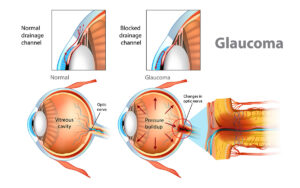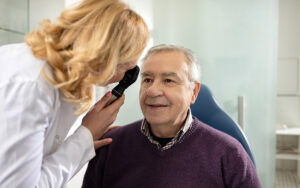Our eyes weren’t built for constant screens. Here’s what really happens when digital life meets daily vision.
Screens are everywhere — from the moment we wake up to the time we fall asleep. Phones, computers, tablets, TVs, and even watches demand our attention, often for hours at a time. While technology connects and empowers us, it also challenges one of our most vital senses: vision.
At Anaheim Eye Institute, we see more patients than ever reporting symptoms like dry eyes, blurred vision, headaches, and neck pain — all signs of digital eye strain. But beyond temporary discomfort, many people wonder: Can too much screen time actually cause lasting damage? The answer is nuanced but important to understand.
What Happens to Your Eyes During Screen Use
When you look at a screen, your eyes work harder than they do when viewing natural surroundings. Reading from digital displays requires constant refocusing, rapid eye movements, and exposure to blue light — a high-energy wavelength that scatters more easily and makes focusing more difficult.
In a typical minute, you blink about 15 to 20 times. However, when staring at a screen, that number drops by nearly half. Fewer blinks mean less tear film and moisture, leading to dryness, irritation, and that familiar burning or gritty sensation.
“Digital devices have changed how we live, but our eyes haven’t evolved to keep up.”
This repetitive strain affects not only your eyes but also the muscles in your neck, shoulders, and back. Over time, it can create a cycle of discomfort that’s hard to break without changing habits.
Common Symptoms of Digital Eye Strain
The American Optometric Association calls this collection of symptoms Computer Vision Syndrome (CVS). Common signs include:
- Blurred or double vision
- Dryness, burning, or tearing
- Difficulty focusing between near and far objects
- Headaches, especially after screen use
- Neck, shoulder, or back pain
- Light sensitivity
- Eye fatigue or heaviness
While these symptoms are temporary for most people, long-term exposure can exacerbate other vision issues or speed up certain age-related changes, especially in individuals already at risk.
Can Screens Cause Permanent Damage?
The good news is that screens don’t directly cause permanent vision loss. However, chronic overuse can lead to secondary effects that negatively impact long-term eye health.
1. Worsening Dry Eye Disease
Reduced blinking during screen use disrupts tear balance, leading to dryness that can become chronic. Over time, this can damage the surface of the cornea, causing inflammation and discomfort.
2. Accelerated Myopia (Nearsightedness)
For children and young adults, prolonged close-up work — including screen use — has been linked to rising rates of myopia. Studies suggest that reduced outdoor activity and increased near focus can alter how the eye grows, leading to blurry distance vision.
3. Blue Light Exposure and Retinal Stress
While current research hasn’t proven that blue light causes permanent eye damage, it does contribute to eye strain and disrupted sleep cycles. Prolonged exposure, especially late at night, interferes with melatonin production and can affect overall wellness.
4. Postural and Muscular Strain
Spending long hours hunched over screens can lead to neck, shoulder, and back pain, which can indirectly affect visual comfort and focus.
“While screens don’t destroy vision, they can certainly erode comfort and quality of life if we don’t take breaks.”
How to Protect Your Eyes in a Digital World
The goal isn’t to avoid screens — that’s nearly impossible — but to use them wisely. Here are some expert-backed strategies from the team at Anaheim Eye Institute to keep your eyes comfortable and healthy in the long run.
1. Follow the 20-20-20 Rule
Every 20 minutes, look away from your screen at something 20 feet away for at least 20 seconds. This gives your focusing muscles a break and helps reset your eyes.
If possible, take longer breaks every hour. Stand up, stretch, and look out a window or across the room. Your eyes — and your posture — will thank you.
2. Adjust Lighting and Screen Settings
Avoid working in dark rooms where your screen is the brightest object. Instead, use soft ambient lighting to reduce contrast and glare.
Most devices also have “Night Shift” or “Eye Comfort” modes that reduce blue light. While these won’t eliminate eye strain entirely, they can make long viewing sessions more comfortable.
3. Blink Intentionally
It may sound simple, but consciously blinking more often helps replenish your tear film and keep your eyes moist. If dryness persists, your ophthalmologist may recommend artificial tears or prescription lubricating drops.
4. Maintain Proper Distance and Posture
Keep your screen about 20–24 inches away and just below eye level. This position reduces the need for excessive eye movement and minimizes neck strain.
Avoid leaning in or tilting your head for long periods. If you wear glasses, make sure your prescription includes an anti-reflective coating or blue light filter for additional comfort.
5. Stay Hydrated and Manage Your Environment
Indoor heating and air conditioning can dry out your eyes even faster. Use a humidifier in dry rooms, and drink plenty of water throughout the day to maintain natural moisture.
“Eye health isn’t just about what you see — it’s about how you treat your eyes every day.”
The Role of Regular Eye Exams
Even if your eyes feel fine, regular checkups are essential for early detection of issues that screens can worsen, such as dry eye disease or myopia.
At Anaheim Eye Institute, comprehensive eye exams include advanced imaging and pressure checks to evaluate overall eye health. If symptoms of digital strain are present, your doctor can recommend personalized strategies or treatments tailored to your lifestyle.
For example, individuals who spend more than six hours per day on screens may benefit from prescription computer glasses, designed specifically for intermediate distances to reduce strain and glare.
Eye Health Tips for Kids and Teens
Children and teens are particularly vulnerable to the effects of excessive screen time. The rise in digital learning and recreational device use has led to increasing rates of nearsightedness in younger populations.
Parents can help by:
- Setting limits on recreational screen time.
- Encouraging outdoor play and natural light exposure.
- Ensuring reading and study environments are well-lit.
- Scheduling annual eye exams, especially if headaches or squinting occur.
Spending just two hours outside each day has been shown to significantly reduce the risk of developing myopia in children. Natural light helps regulate eye growth and supports long-term vision stability.
When to See an Eye Doctor
If you experience persistent headaches, blurred vision, or dry eyes that don’t improve with rest or over-the-counter solutions, it’s time for a professional evaluation. Other warning signs include:
- Double vision or difficulty focusing
- Frequent eye rubbing or watering
- Sensitivity to light
- Increasing trouble seeing at night
A comprehensive exam can rule out underlying issues such as astigmatism, presbyopia, or eye pressure irregularities that can worsen with screen use.
Building a Sustainable Vision Lifestyle
Our digital world isn’t going anywhere, but that doesn’t mean your vision has to suffer. Think of eye care as a partnership — your habits support your doctor’s expertise.
Balance is the real goal. Short breaks, intentional blinking, hydration, and regular exams all work together to prevent strain and maintain clarity. It’s about making small changes that add up to long-term comfort and confidence.
At Anaheim Eye Institute, our specialists combine advanced diagnostics with practical guidance to help patients thrive in today’s screen-filled environment. Whether you’re a professional, student, or parent, we can help you find a plan that keeps your vision healthy in the digital age.
See the Difference
If your eyes feel fatigued, dry, or strained, you’re not alone — but you don’t have to live with it.
Schedule a comprehensive eye exam at Anaheim Eye Institute today to assess your screen-related eye health, explore treatment options, and build sustainable habits for a clearer, more comfortable future.




